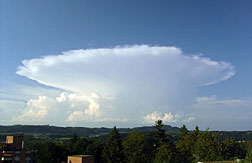- Number 366 |
- July 2, 2012
Thunderclouds and pollution team up to warm atmosphere

An anvil cloud looms over the Southern
Great Plains site location of DOE’s
Atmospheric Radiation Measurements
Climate Research Facility.
For the first time, researchers at DOE’s Pacific Northwest National Laboratory have shown that pollution increases warming in the atmosphere through enlarging thunderstorm clouds. The scientists conducted a computational study with resolutions high enough to show the clouds developing. They found that for warm summer thunderstorms, pollution particles lead to stronger storms with larger, anvil-shaped clouds, which also last longer. The warming effect dominated by trapping more heat, especially at night, even though these larger clouds also reflected more daytime sunlight warmth back into space.
Clouds are one of the most poorly understood components of the Earth's climate system. Getting a better understanding of clouds, and how atmospheric particles affect them, is important to better predict the future of climate change.
"Global climate models don't see this effect because thunderstorm clouds simulated in those models do not include enough detail," said Dr. Jiwen Fan, lead author and a scientist at PNNL. "The large amount of heat trapped by the pollution-enhanced clouds could potentially impact regional circulation and modify weather systems."
DOE’s Office of Science and Biological and Environmental Research Regional & Global Climate Modeling Program supported this research as part of a bilateral agreement with the China Ministry of Sciences and Technology on regional climate research and DOE BER's Atmospheric System Research Program.
[Kristin Manke, 509.372.6011,
kristin.manke@pnnl.gov]
